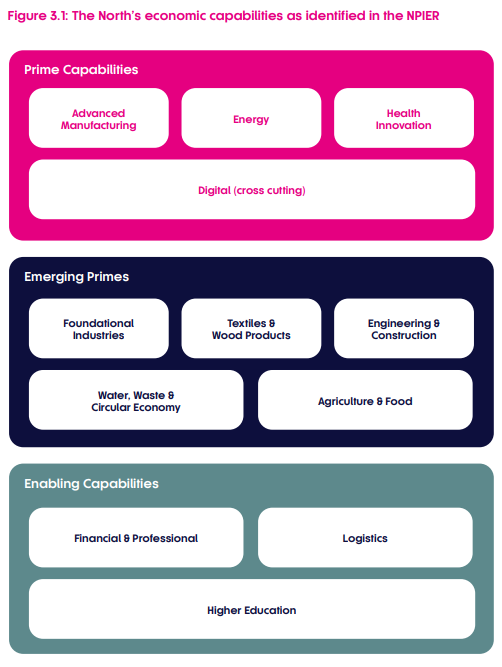







Home to 15.6 million people and 1.1 million businesses, the North of England supports 7.3 million jobs, and in 2021 it produced £386 billion Gross Value Added (GVA) – equivalent to almost 19% of the overall UK economy.
However, with its population accounting for over 23% of the UK population, the North has significant unrealised economic potential. A persistent historical gap in productivity (a key measure of economic performance, measuring economic outputs relative to inputs) exists between the North and the rest of England. Productivity gaps also exist across the North itself. Improving productivity across the whole of the North is important, as lower productivity results in lower wages and living standards, and is also linked to lower skills, lower enterprise rates, poorer health outcomes, and shorter life expectancy.
The Northern Powerhouse Independent Economic Review (NPIER), originally published in 2016, was a strategic long-term assessment of the North’s economy and its potential for growth. This review identified seven key sectoral capabilities in the North that have the potential to support transformational growth, coupled with sustained investment in transport connectivity, skills, research and development (R&D), graduate retention, and inward investment – all factors which could help the North close its productivity gap.
The NPIER also identified the limited realisation of agglomeration benefits (opportunities arising from people and businesses clustering together) as a weakness of the North’s economy, and identified poor transport connectivity between the North’s key economic centres as a barrier to creating integrated labour markets that can drive sustainable productivity growth across the whole region.
Improved transport can be a catalyst for change in people’s lives, bringing opportunity and choice to communities and businesses. The NPIER and the North’s Strategic Transport Plan identify the fundamental need for transport investment to provide more (and faster) passenger and freight connections between the North’s economic centres, as well as to other parts of the UK and international gateways, to realise the benefits of agglomeration and unlock sustainable economic growth.
The NPIER provides the strategic economic context for the North’s Strategic Transport Plan and is embedded in the local transport plans and economic strategies across the region. From 2021 to 2023, an update of the NPIER was undertaken in recognition of changes since 2016, such as the policy importance of Net Zero, and Covid-19 impacts. The new assessment confirms the opportunity from, and continued importance of, the seven ‘prime and enabling capabilities’ of the North’s economy, as well as emerging and wider sectoral strengths, including in engineering, construction, food and agriculture. The North’s foundational economy was also identified as significant, estimated to currently employ 67% of the North’s workforce and generating 63% of all economic output.
The first NPIER modelled a transformational scenario in which sustained additional investment into the North across a range of policy areas enables the North to close its productivity with the rest of England (less London) by 2050. Refreshed scenario modelling was carried out as part of the 2023 NPIER update, with a greater focus on the policy levers required to achieve the transformational vision, developing a set of scenarios representing different packages of additional investment (at the level the North has historically been under-funded to compared to other parts of UK) to improve outcomes in areas such as trade and investment, skills and health, housing and infrastructure, and the delivery of net zero.
The revised transformational scenario for the North involves all of those investment packages being delivered simultaneously for the best outcomes: an economy that is £118bn larger and supports 1 million additional jobs by 2050 compared to a business-as-usual scenario, closing of the productivity gap, as well as reduced worklessness, higher wages, increased life expectancy, and reduced carbon emissions. The scenario also demonstrates how this additional investment could result in strong economic and fiscal returns to the UK economy and the public purse.

CLOSE POPUP [X]